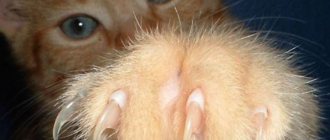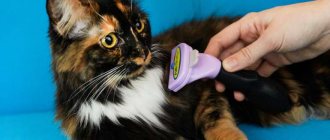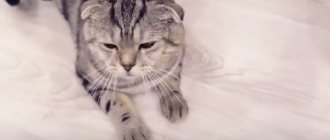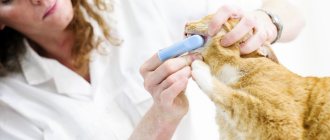Does a predator need to trim its claws?
If an animal lives in the wild, catching it and cutting off its claws is at least inhumane, but if we are talking about a pet, this is not only possible, but must be done! Cats love to scratch furniture, and even a purchased scratching post does not always help.
Many owners are in favor of trimming their nails - this way the animal will not damage the furniture or injure itself. Cats often scratch their ears, and an open wound can become infected. Also, cutting nails is mandatory if there is more than one pet in the house - in games they can injure each other.
Why you shouldn’t do onychotomy
Many owners, tired of problems with damaged furniture and torn walls, decide to take radical measures - onychectomy. There is definitely no need to do this!
Surgical intervention involving complete declawing is possible only for medical reasons, and not to satisfy the wishes and whims of the cat owner. “Soft paws” can solve the problem of property damage, but deprive the pet of natural protection and the necessary skills for living in a normal environment. They certainly make him flawed and cause irreparable harm to the psyche.
Even with positive results of the operation, after recovery, the pet will never be the same as before. Knowing this, it’s worth thinking: should you decide or not?
Fluffy four-legged pets decorate human life, but require care and attention. They have their own reflexes, natural instincts, which owners do not always like. When finally deciding to get a cat, it is important to remember: this is not a toy, but a living creature!
Tools for work
For the procedure, a special device is used: a nail clipper. No need to use nail scissors - they are for human use only.
A cat has 5 toes on its front paws and 4 on its back paws.
Types of nail clippers:
- Secateurs - there is a spring between the handles of the product. The secateurs include a limiter in its design - with its help you can cut the desired length.
- Blisters are similar in appearance to manicure scissors, but their tips have curved blades designed for cat claws.
- Guillotines are similar to cigar scissors. The claw is inserted into the hole at the tip - when the handles are activated, the blade comes down and cuts off the cat's claw. This tool is suitable for cats with thick claws. They cut from bottom to top (this is very important to remember!) otherwise there is a risk of crushing the nail plate.
Each cat owner chooses a tool that suits the requirements and facilitates the procedure. To make the task easier, you can purchase an electric trimmer, but don’t be surprised if your cat starts to get nervous and bulge her eyes. A buzzing device scares most cats.
Why do you need to cut your hair?
A cat's claws grow daily; animals visiting the street wear down the tips of their nails, climbing trees, walking on the asphalt. A pet does not have this opportunity, and daily sharpening on a scratching post makes them especially sharp.
Too long claws bother the cat; the pet tries to chew off the ends on its own and sharpens its nails on hard surfaces.
Don't forget about the fifth nail; its location on the front paws is such that at home the nail is constantly growing, and playing with a scratching post will not help here. Over time, too long a nail digs into the pad of the front paw, causing the animal discomfort when moving, affecting the animal's activity.
The process of growth of nail plates is individual, one cat needs to be trimmed once every thirty days, another every two weeks.
The circumcision procedure can be performed at a veterinary clinic or you can do a “cat manicure” yourself.
To cut your hair at home, you need to get professional equipment.
On a note! It is unacceptable to cut nail plates using manicure or kitchen scissors; such tools can injure the animal, damage blood vessels on the fingers, and introduce infection into the body.
Be sure to read:
How to wash a cat’s eyes at home: pharmacy and folk remedies, when required
The owner should buy a trimmer (nail clipper) at a pet store; the device is a guillotine-type scissors; with the help of a nail clipper, it will be possible to remove the excess length without harming the health of the pet.
Preparing for a haircut
An animal experiences stress when its owners start something “against” it. It’s worth starting with preparatory procedures, and preferably from infancy. Adult animals are reluctant to change. Without preparation, the cat may be injured.
The right moment is chosen for a haircut. The cat should be free from business: food or games. The animal is picked up and gently stroked, so the pet relaxes. Slowly, from stroking the back and head, the owner moves on to the cat’s paws - stroking and massaging them.
The main thing is that the cat’s attention should be scattered - it should not break out or suspect something is wrong.
You need to allocate 2-3 days for preparatory procedures. When you touch their paws, you will notice the cat's irritation - they do not like their paws being touched. If you regularly repeat the procedure, the growing kitten will get used to it, the main thing is to provide an “anchor” for it in the form of a treat after the process.
After the kitten gets used to touching, the next stage begins - imitation of a haircut:
- the kitten is placed in a suitable position;
- touch the animal on different paws;
- inspect the claws and press on the pads.
After the procedure, the kitten will be grateful if his patience pays off with treats. The kitten also gets to know the nail clipper for the first time - he must understand that the tool will not harm him. When he begins to accept it calmly, you can get a haircut.
At what age can you cut your hair?
The second most important question in this matter is: when should you start trimming your nails? Some veterinarians suggest accustoming an animal to trimming its claws from 2-3 months, others from 3-4 months. This is the optimal age for introducing the procedure into animal care. The sooner you start doing this, the faster your pet will get used to these actions and at the sight of scissors or nippers he will not hiss, bite or hide from you, hoping that you will leave him alone. After all, the older the pet, the more difficult it will be for him to get used to the haircut.
Step-by-step instruction
Kittens are accustomed to grooming from the age of 2 months. The place for the procedure should be well lit. A cat's claws are a keratinized layer that hides the pulp, a collection of nerve endings. When trimming the nails, it is advisable not to touch this area, since then the pet will experience pain.
In some cats, the pulp is clearly visible, and in good lighting you can see a pink, crescent-shaped area on the nails. Haircuts with dark pigmentation are more difficult - in this case you will have to act at random. You can cut off 1 mm at a time - when the color becomes lighter, it means the pulp begins.
Before cutting, it is advisable to trim the fur between the claws, otherwise it will get in the way. Before the actual procedure, the nail clipper and hands are disinfected. Nearby are placed attributes that may be useful in case of injury: antiseptic and cotton wool (preferably cotton pads).
Step-by-step instruction:
- Having taken a comfortable position, the owner sits the pet on his lap. You can put a cat on its back, but not all predators accept this. If the animal is too active, you can wrap it in something.
- Press down on the cat's pad until the claw appears.
- If your cat doesn't flinch at the sight of a nail clipper, you can cut off the nail. The animal may become agitated by what has happened, in which case it needs to be petted and calmed down.
- With quick movements, the nail clipper is set to 1 mm. to the pulp. The claws are trimmed so that the edge remains pointed. If the claw is cut incorrectly, there is a risk of damaging the pulp.
- At the end of the procedure, the claw is rounded using a regular file. If you make it a rule to sharpen the animal's claws, their trimming will be reduced to a minimum.
Many cats hiss because they are afraid. Preparatory procedures are required. To prevent your cat from becoming stressed, you can trim 1 nail every day.
How to cut your hair correctly: description of the procedure
Before starting the procedure, you need to carefully examine the structure of the nail, it consists of a translucent nail plate of a curved shape, at the base of the finger the claw is darker, in this place the pulp (the area of blood vessels) is located. Trimming should be done without touching the pulp, so as not to injure the cat.
The trimming procedure does not cause pain to the animal, but often the cat gets nervous and breaks out during the trimming. It is best to do the haircut together: one holds the pet, the other trims the claws. To bring a cat out of an anxious state, calm it down, and relieve stress, you should continuously stroke the animal and talk in a gentle voice.
Algorithm of actions:
- Sit on your hands, take the paw, fix the finger, press on the base so that the entire claw is outside.
- Examine the nail plate in the light to see where the pulp begins.
- Place the nail clipper perpendicular to the surface of the nail, without reaching the pulp, and cut off the tip in one motion.
- Use a nail file to smooth out any sharp edges.
- At the end of the unpleasant procedure, pet the animal and give it its favorite food.
Be sure to read:
Proper care of kittens at home in the first 1-2 months, what to do
What can't you do?
Cats, like all people, are sensitive to their environment. They also read the emotions and mood of their owners.
What not to do during a haircut:
- scream and get irritated - the pet will experience even greater fear, and in the future it will be very difficult to get him to agree to the procedure;
- force by force - there is no need to force the animal to submit by violent means;
- catching a kitten during games - he will not say “thank you” for this, but indignation and aggression on the part of the pet are guaranteed.
What to do if your pet gets injured while trimming its nails
If the pulp of a dog or cat is damaged, stop the procedure immediately and treat the wound. Try not to get nervous or raise your voice to a frightened animal.
Be sure to treat the wound if you accidentally injure your pet / vetcallashmore.com.au
Be sure to have supplies on hand to help stop the bleeding. For example, you can use hydrogen peroxide or special antiseptic powder. Alcohol-based medications are not the best solution for such situations; they will increase the pain.
Another undesirable consequence of trimming a dog’s nails is the undermining of the nail. It can happen if the dog sharply jerks its paw at the moment when you slowly and hesitantly bring the blades of the tool together. As a result, the skin and sometimes soft tissues are injured.
If your pet has a claw tear, bandage the paw with a bandage or tourniquet and lift it up. This will help stop the bleeding. Apply a cold compress. To do this, remove the ice or food from the freezer, put it in a clean bag and wrap it in a towel. Leave the compress on for a couple of minutes and then take a short break. When the bleeding stops, treat the wound with healing ointment from a veterinary pharmacy and bandage it. Be sure to contact your veterinarian afterwards.
What to do if your cat is bleeding
Blood may flow if a capillary is damaged - this is not scary. There are almost no nerve endings at the tip of the claw, so the cat does not experience pain. But if the pulp is affected, it is more serious.
What measures need to be taken:
- treat the wound with an antiseptic solution (peroxide or potassium permanganate solution - it is advisable to dilute a weak one). A hemostatic sponge is also suitable;
- apply dry potassium permanganate or powder that stops bleeding (hemostatic powder) to the wound;
- take the animal to the veterinarian if the bleeding cannot be stopped.
How to trim a small kitten's claws
There is no particular need to trim the claws of a newborn kitten. An exception may be those rare cases when you have to feed an orphaned baby. At the first uncertain steps, the claws get caught and get injured (bend in the opposite direction). Once upon a time, his mother cat saved him, rescuing him from difficult situations and gnawing off broken parts of his claws. But if there is no mother, an emergency adjustment is required on the part of the owner.
At the age of 3-3.5 months, it’s time to start practicing this procedure. A kitten trained at an early age will react calmly to subsequent haircuts, without unnecessary emotions. You should not try to trim all the claws in one go. Especially without having the proper experience. 1-2 skillfully processed claws are better than accidentally injuring the fidgety fidget.
Important! The most appropriate tool for a kitten is a nail cutter-secateurs (nail cutter-scissors), it will reduce the risk of damage to zero.
If the claws remain unshortened
Overgrown claws bring a lot of discomfort to the cat - they peel off. The kitten will want to cling to soft surfaces such as carpets or sofas, which can lead to inflammation. Long claws dig into soft pads, which can lead to lameness. Due to pain, the cat cannot actively move, begins to lick its paws and tries to bite off the ill-fated claw.
As long as the surrounding tissues are not inflamed, it is enough to carefully trim off the ingrown toenail. In advanced cases, you cannot do without the help of veterinarians.
Trimming a cat's claws is both a difficult and simple task, the main thing is to remember all the rules, purchase the necessary tools and accustom the cat to the procedure in advance, while it is growing up. Older animals become stubborn.
Trimming a cat's claws at home
The basic rule that an owner should learn before trimming a cat's claws is to never use regular scissors or your own manicure accessories . The only exception to this rule is the sanding nail file.
In specialized pet stores or veterinary pharmacies today, there is a large selection of various accessories for caring for cats, including tools for trimming claws.
Blisters and nail clippers
Special accessories for trimming nails can be purchased at a veterinary store.
First of all, the owner needs to purchase special scissors . They are called blister and are a little like ordinary nail scissors, but they have sharper blades and their very shape is adjusted to a cat's claw.
The so-called nail clippers are also popular among owners of furry pets. They resemble small pliers or forceps and come in two types: sickle and guillotine.
After trimming the nails, you can polish them a little with a nail file.
Damage from nail trimming
The picture shows where the cat's claws need to be trimmed.
In addition to cutting tools, it is also advisable to have iodine, hydrogen peroxide and baby talc . After all, it is not always possible to carefully cut off the tip of the claw, and then its tip begins to bleed. You can treat the wound with hydrogen peroxide and then sprinkle it with talcum powder.
Owners of fluffy cat breeds, such as Persians or Siberians, also need to prepare a hair clipper . After all, cats with long, luxurious fur grow thick tufts of hair on their paw pads, which prevent free access to their claws. If the animal is frightened by the noise of the clipper, you can trim the tufts of fur with scissors.
Before each use of scissors or tweezers, they should be treated with an alcohol solution.
Accessories
Blue model of scissors
Red scissors model
One of the most popular cat nail clippers on the market
Guillotine nail clipper
Required accessories:
- Special cat scissors.
- Crescent or guillotine tweezers.
- Nail file.
Accessories:
- Cotton wool or cotton swabs.
- Alcohol solution.
- Antiseptics (hydrogen peroxide, iodine).
- Children's talc;
Jar of hydrogen peroxide
Nail trimming should be approached with all responsibility and be sure to keep all manicure accessories clean so as not to introduce an infection to your pet.
Basic Rules
Of course, you can entrust such a responsible and scrupulous procedure as trimming a cat’s claws to qualified specialists working in a pet salon. But there is not always time or opportunity to take a pet to a salon, so the owner needs to learn how to trim a cat’s claws correctly.
A cat's claw consists not only of the cornea; inside the keratinized part there are nerve endings and blood vessels, which together make up the so-called pulp. If the pulp is caught during circumcision, it will begin to bleed, and the cat will experience severe pain and may even limp for several days. Therefore, only one or two millimeters of the cornea is cut off.
Apply slight pressure on the pad until claws appear
This should only be done during the day, preferably near a window, so that the owner can clearly see the claw itself. You should take the pet on your lap and, while talking to it affectionately, lightly press on the pad of its paw so that its claws appear. Then carefully cut off the upper keratinized part of the claw with tweezers.
This procedure must be done not only on the front legs, but also on the hind legs.
After cutting the claws is completed, the ends of the cut can be sanded with a nail file and treated with an antiseptic.
Upon completion of the procedure, you can treat your pet with his favorite treat , not forgetting to praise him for his exemplary behavior.











